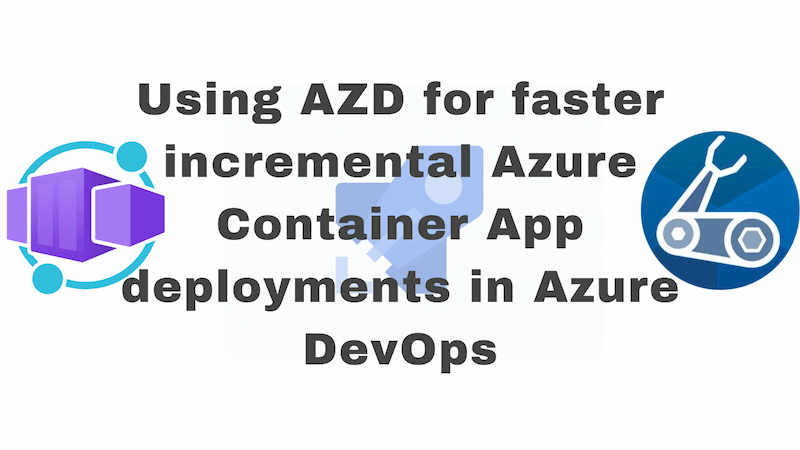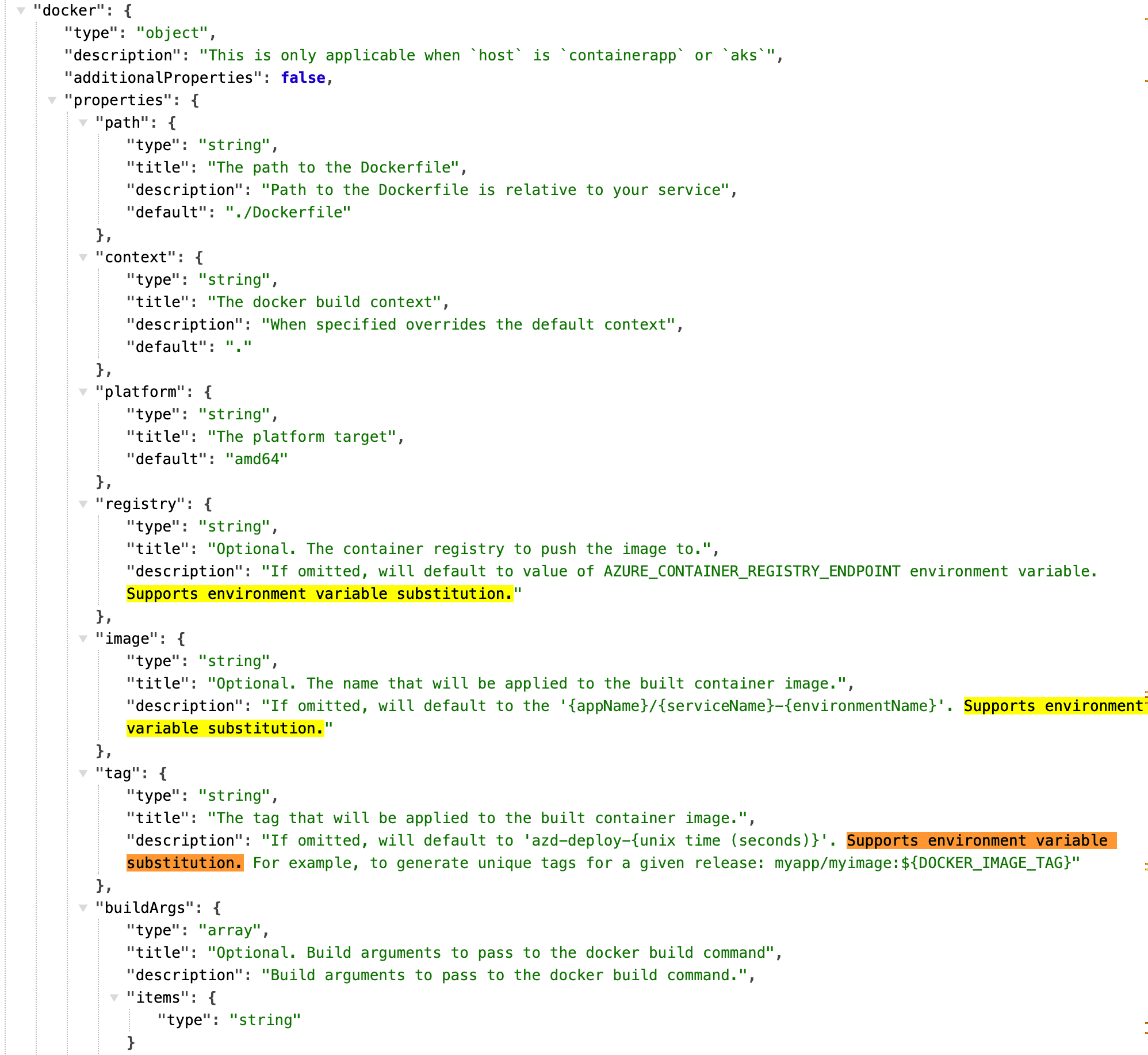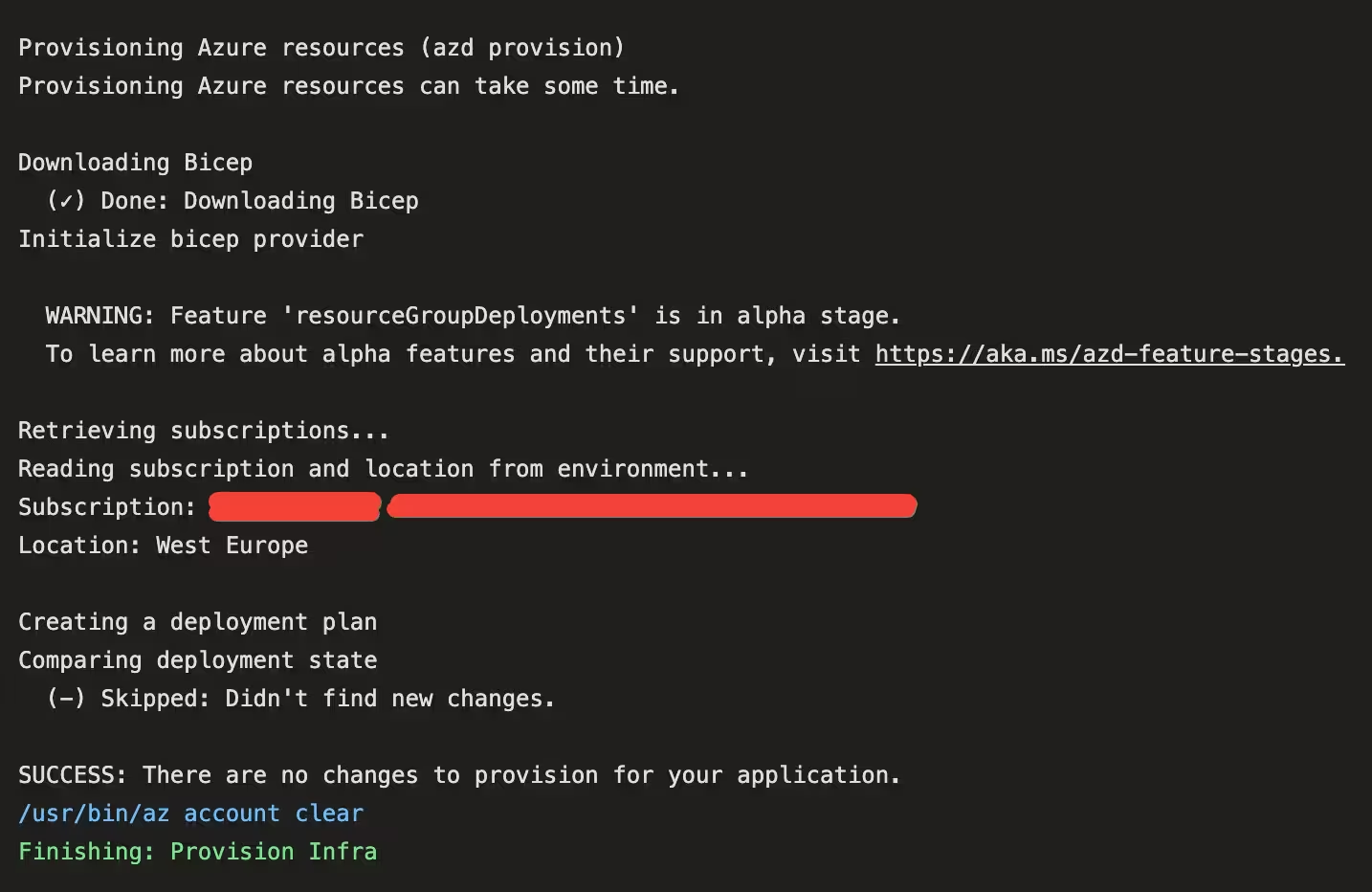Using AZD for faster incremental Azure Container App deployments in Azure DevOps
When deploying Azure Container Apps from Azure DevOps, you can use the azd command to speed up deployments that do not affect infrastructure. Given that when you're deploying, it's far more common to be making a code and / or content change and not an infrastructure one, this can be a significant time saver.

If you're looking for information on how to use azd to speed up deployments of Azure Static Web Apps in GitHub Actions, then you might want to read this post.
Faster deployments from azd 1.4 and beyond
The azd v1.4.0 release contained a significant feature: azd provision is now faster when there are no infrastructure changes.
To quote a trimmed down version of the announcement:
If you’ve been using the Azure Developer CLI for a while, you may have noticed that sometimes
azd provisiontakes a long time to complete when it may not need to. The wait time was because, prior to version 1.4.0,azd provisionwould always reprovision regardless of whether the underlying Infrastructure as Code had changed... As of today’s 1.4.0 release,azd provisionnow checks the most recent deployment upstream on Azure to see if the state is the same as what’s represented in the Infrastructure as Code that’s been used to provision. If the state is the same, the provision is skipped... with this new experience, you should also notice improved performance when runningazd upin a CI/CD pipeline as provisioning will be automatically skipped when there are no changes.
I want this. We're going to unpack how to use this feature in the context of an Azure DevOps pipeline with Azure Container Apps. It turns out that there's a little more to it than just running azd provision and hoping for the best. In fact, there's gotchas aplenty - but it's totally achievable.
What about Bicep what-if?
You might be thinking at this point: "What about Bicep what-if?" It's a good question. what-if is a feature of the Azure CLI that allows you to see what changes would be made if you were to deploy a Bicep file. Unfortunately, my own experience of using what-if has been that it's quite unreliable. It will detect changes where there are none, and it will fail to detect changes where there are some. I'd love to use it, but I can't trust it. If you'd like to watch a more in depth discussion of the issue, this video is a good place to start.
There appear to be some known issues with what-if that you can follow the progress of here:
- https://github.com/Azure/arm-template-whatif/issues/83
- https://github.com/Azure/arm-template-whatif/issues/157
Given that what-if is not reliable, we're going to use azd to speed up our deployments.
Embracing azd in an existing Azure DevOps pipeline
I'm going to start with a pre-existing Azure Pipeline that deploys an Azure Container App. It uses the classic AzureResourceManagerTemplateDeployment@3 ARM template deployment v3 task to deploy our infrastructure in the form of a main.bicep (and it's submodules) file.
This existing pipeline and infrastructure as code payload is in a good state. But it's slow. Every time the pipeline runs, the bicep section takes 8 minutes. We're going to make it faster. Spoiler: we're going to get it down to 1 minute.
Hello azure.yml
Our project has no integration with azd. But we need azd to take advantage of the new azd provision feature. We're going to add a new file to our project: azure.yml. This file is going to contain the configuration for our azd project.
# yaml-language-server: $schema=https://raw.githubusercontent.com/Azure/azure-dev/main/schemas/v1.0/azure.yaml.json
name: my-container-app
metadata:
template: azd-init@1.9.4
services:
web:
image: myregistry.azurecr.io/my-project/my-container-app:${WEB_VERSION_TAG}
host: containerapp
resourceName: ${CONTAINER_APP_NAME}
The yaml above describes a container app service called web that uses an image from an Azure Container Registry. The WEB_VERSION_TAG is a variable that we'll need to provide in our Azure DevOps pipeline. It's worth noticing the link at the top to the schema for the azure.yml file: https://raw.githubusercontent.com/Azure/azure-dev/main/schemas/v1.0/azure.yaml.json - much of the work around figuring out how to use azd was achieved by looking at the schema for the azure.yml file.
One thing we learned, as we looked at the schema, was that many parameters support environment variable substitution at runtime:

The screenshot above is taken from the Docker section of the configuration where environment variable substitution is widely supported. Originally the image parameter did not support substitution. It does as of v1.10.0.
You'll notice that we pass resourceName: ${CONTAINER_APP_NAME}. You'll see later that we supply the CONTAINER_APP_NAME and this will be consumed by the azd deploy stage.
Incidentally, we're using an approach whereby the image is built and pushed to the registry independently of azd. You could equally use azd to build and push the image. But we're not doing that here.
Bicep modifications
I mentioned that we're adding a level of azd support to an existing pipeline. As part of that, we need to make modifications to our existing Bicep modules.
Using resource group scoped deployments with azd
We're going to start off with a minor tweak to our main.bicep file; the entry point to our Bicep deployments.
targetScope = 'resourceGroup'
The change above allows us to use azd deployments targeted at existing resource groups. The default mode of operation for azd deployments is deploying a resource group to a subscription. We are seeking to deploy to an existing resource group.
Now, strictly speaking, this isn't necessary for speeding up deployments with azd. But if you're not one for creating a resource group per deployment (as I am not), then this is a good idea. This kind of deployment requires less permissions and may well better align with your organisation's security posture.
We'll need to opt into using this feature with azd later on in the pipeline; at present resource group scoped deployments are considered "beta".
The "does your service exist?" parameter
We're going to add a "magic" parameter to our main.bicep file. This parameter is going to be used to determine whether the container app we're deploying already exists. This is important because if the container app already exists, we will reuse the existing deployed container image during the azd provision stage. If it does not, then we'll deploy a new container image.
@description('Specifies if the container app exists - azd will provide this')
param containerAppExists bool = false
We'll look later at where this value comes from, but for now, we're just adding it to our main.bicep file. How do we use this parameter? In the module where we deploy our container app, we're going to make a couple of changes:
module fetchLatestImage '../modules/fetch-container-image.bicep' = {
name: '${name}-fetch-image'
params: {
exists: containerAppExists
name: name
}
}
resource app 'Microsoft.App/containerApps@2023-05-01' = {
name: name
location: location
tags: union(tags, {'azd-service-name': 'web' }) // note the "web" matches the service name in azure.yml
// ...
properties: {
// ...
template: {
containers: [
{
image: fetchLatestImage.outputs.?containers[?0].?image ?? 'mcr.microsoft.com/azuredocs/containerapps-helloworld:latest'
// ...
}
]
// ...
}
}
}
You can see we tag the container app with the service name from the azure.yml file (web). This is important because it allows azd to determine whether the container app already exists and so power the containerAppExists parameter we added to our main.bicep file.
We're using the containerAppExists parameter to determine whether we should fetch the currently deployed image from the existing container app. If the container app exists, we'll use the existing image. If it does not, we'll use a default image. We'd typically only expect to use the default image when we're deploying the container app to an environment for the first time. (You might be wondering how the new version of the application gets deployed; given that we're not using the new container image. It turns out that azd deploy is the command responsible for deploying the new image; we'll get to that later.)
You'll have noticed that we're using a new module called fetch-container-image.bicep. This module is responsible for attempting to fetch the existing image from the currently deployed container app:
param exists bool
param name string
resource existingApp 'Microsoft.App/containerApps@2023-05-01' existing = if (exists) {
name: name
}
output containers array = exists ? existingApp.properties.template.containers : []
This is based on what files are generated when you perform an azd init, but has been customised for the specific version of the Microsoft.App/containerApps resource we're using.
Tagging resources with the environment name
Another addition we're going to make to our main.bicep file is to tag our resources with the environment name. This allows azd to determine the environment of a given resource. It's achieved by using the our already existing envName parameter and adding it to the tags of our resources:
@description('Environment eg dev, prod')
param envName string
// ...
var combinedTags = union(tags, { 'azd-env-name': envName })
Parameters in main.bicep must be immutable per environment
It's gotcha time! One thing we learned the hard way is that parameters in main.bicep must be immutable per environment. This means that you can't change the value of a parameter in a main.bicep file between deployments to an environment. This is because azd uses the main.bicep file to determine whether a deployment is incremental or not. If the parameters change, then azd will assume that the deployment requires infrastructure changes, and will reprovision the resources.
What's more, as things stand, azd only has the ability to fully reprovision your resources. If your app consists of a database and a container app, and you only want to deploy a new version of the container app, you're out of luck. azd will deploy the database again too. This is a limitation of azd at the time of writing.
I've raised a GitHub issue in the hope that this feature might one day land. Perhaps it's super hard - quite possibly.
Welcome main.bicepparam
Prior to using azd, we were using a main.bicep file to deploy our infrastructure and we provided parameters to this file via our Azure DevOps pipeline. We're going to make a change to our pipeline to use a main.bicepparam file instead.
The main.bicepparam file is going to contain the parameters that we were previously providing to our main.bicep file. It's going to pick these up from environment variables that we'll declare. We're also going to add our new containerAppExists parameter to this file, which will also collect its value from an environment variable. But it won't be us that provides that value; it will be azd.
Consider the following (cut down) main.bicepparam file:
using './main.bicep'
param envName = readEnvironmentVariable('AZURE_ENV_NAME', '')
param location = readEnvironmentVariable('AZURE_LOCATION', '')
param serviceConnectionPrincipalId = readEnvironmentVariable('AZURE_PRINCIPAL_ID', '')
param tags = {
branch: readEnvironmentVariable('TAGS_BRANCH', '')
repo: readEnvironmentVariable('TAGS_REPO', '')
}
// ...
// azd will provide the following parameters
param containerAppExists = bool(readEnvironmentVariable('SERVICE_WEB_RESOURCE_EXISTS', 'false'))
The containerAppExists parameter is determined by the SERVICE_WEB_RESOURCE_EXISTS environment variable to provide this value. What's happening here is that we're picking up on a convention that azd uses to provide confirmation that a service already exists. SERVICE_[SERVICENAME]_RESOURCE_EXISTS is the pattern that azd uses to provide this information; where [SERVICENAME] is the name of the service as defined in the azure.yml file. In our case, it's web (or rather WEB).
If you're curious about how this actually works you can read the source code here in the azd project. Here's the relevant code snippet:
func (at *containerAppTarget) addPreProvisionChecks(ctx context.Context, serviceConfig *ServiceConfig) error {
// Attempt to retrieve the target resource for the current service
// This allows the resource deployment to detect whether or not to pull existing container image during
// provision operation to avoid resetting the container app back to a default image
return serviceConfig.Project.AddHandler("preprovision", func(ctx context.Context, args ProjectLifecycleEventArgs) error {
exists := false
// Check if the target resource already exists
targetResource, err := at.resourceManager.GetTargetResource(ctx, at.env.GetSubscriptionId(), serviceConfig)
if targetResource != nil && err == nil {
exists = true
}
at.env.SetServiceProperty(serviceConfig.Name, "RESOURCE_EXISTS", strconv.FormatBool(exists))
return at.envManager.Save(ctx, at.env)
})
}
Now that we have our main.bicepparam file, we're ready to migrate to our pipeline to use azd.
Azure DevOps pipeline modifications
There's no two ways about it; our Azure DevOps pipeline modifications are pretty extensive. Where we were previously using the AzureResourceManagerTemplateDeployment@3 task to deploy our Bicep files, we're now going to use the azd command to deploy our infrastructure and our container app.
Here's a cut down version of our pipeline replacing the single AzureResourceManagerTemplateDeployment@3 task with a series of tasks that use the azd command:
- task: setup-azd@0
displayName: Install azd
# If you can't use above task in your organization, you can remove it and uncomment below task to install azd
# - task: Bash@3
# displayName: Install azd
# inputs:
# targetType: "inline"
# script: |
# curl -fsSL https://aka.ms/install-azd.sh | bash
- pwsh: |
azd config set auth.useAzCliAuth "true"
displayName: Configure `azd` config options.
- task: AzureCLI@2
displayName: Login to ACR
inputs:
azureSubscription: $(registryServiceConnection)
scriptType: bash
scriptLocation: inlineScript
inlineScript: |
az acr login -n myregistry
- task: AzureCLI@2
displayName: Provision Infra
inputs:
azureSubscription: $(serviceConnection)
scriptType: bash
scriptLocation: inlineScript
inlineScript: |
azd provision --no-prompt
env:
# See https://learn.microsoft.com/en-gb/azure/developer/azure-developer-cli/configure-devops-pipeline?tabs=azdo
AZURE_LOCATION: $(location)
AZURE_SUBSCRIPTION_ID: $(subscriptionId)
AZURE_ENV_NAME: ${{parameters.env}}
# https://learn.microsoft.com/en-us/azure/developer/azure-developer-cli/manage-environment-variables#user-provided-environment-variables
AZURE_RESOURCE_GROUP: $(resourceGroupName)
AZURE_PRINCIPAL_ID: $(serviceConnectionPrincipalId)
# Define the additional variables or secrets that are required only for provision
TAGS_BRANCH: $(Build.SourceBranch)
TAGS_REPO: $(repo)
CONTAINER_APP_NAME: $(myContainerAppName)
# ...
- task: AzureCLI@2
displayName: Deploy Application
retryCountOnTaskFailure: 2
inputs:
azureSubscription: $(serviceConnection)
scriptType: bash
scriptLocation: inlineScript
inlineScript: |
azd deploy --no-prompt
env:
# See https://learn.microsoft.com/en-gb/azure/developer/azure-developer-cli/configure-devops-pipeline?tabs=azdo
AZURE_LOCATION: $(location)
AZURE_SUBSCRIPTION_ID: $(subscriptionId)
AZURE_ENV_NAME: ${{parameters.env}}
# https://learn.microsoft.com/en-us/azure/developer/azure-developer-cli/manage-environment-variables#user-provided-environment-variables
AZURE_RESOURCE_GROUP: $(resourceGroupName)
# Define the additional variables or secrets that are required only for deploy
CONTAINER_APP_NAME: $(myContainerAppName) # this is used to substitute the CONTAINER_APP_NAME value in the azure.yaml file
# ...
What's happening here? We'll take it step by step:
- We're installing
azdusing thesetup-azd@0task. - We're configuring
azdto use the Azure CLI for authentication and to enable resource group scoped deployments. - We're logging into our Azure Container Registry. (If you're not building your image independently of
azd, then you may not need this step.) - We're provisioning our infrastructure using
azd provision --no-prompt. Note that we're providing a number of environment variables toazdwhich will be detected in ourmain.bicepparamfile. - We're deploying our application using
azd deploy --no-prompt. As we do that, we pass theCONTAINER_APP_NAMEenvironment variable which will substitute into theazure.yamlfile
You'll note that as we use azd, we make heavy use of environment variables. These environment variables will be picked up in the main.bicepparam file and passed through to the main.bicep. And of course there's the runtime SERVICE_[SERVICENAME]_RESOURCE_EXISTS parameter which azd will provide. Much of what you see here is inspired by this documentation.
What does it look like when it works?
That is the question! Like this:

The magic sentence in the above screenshot is: SUCCESS: There are no changes to provision for your application. This is what we're looking for. This is what makes our deployments faster.
Conclusion
So we've done it, we've speeded up our subsequent deployments by using azd in our Azure DevOps pipeline to avoid unnecessary infrastructure provisioning when there are no changes. This is a significant time saver. However, as we've also seen, this is very easy to get wrong and quite hard to get right! Hopefully this will help you implement azd in your Azure DevOps pipelines.
I couldn't have written this without Marcel Michau who did much of the heavy lifting on this project. I am the Boswell to his Johnson. Or something like that.
